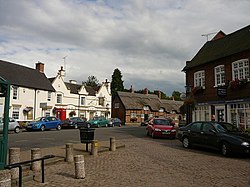Market Bosworth
| Market Bosworth | |
| Leicestershire | |
|---|---|
 Market Bosworth Market Place | |
| Location | |
| Grid reference: | SK4003 |
| Location: | 52°37’26"N, 1°24’6"W |
| Data | |
| Population: | 1,906 (2001) |
| Post town: | Nuneaton |
| Postcode: | CV13 |
| Dialling code: | 01455 |
| Local Government | |
| Council: | Hinckley and Bosworth |
| Parliamentary constituency: |
Bosworth |
Market Bosworth is a small market town in Leicestershire. It is historically famous for the Battle of Bosworth fought nearby on 22 August 1485.
The heart of the little town is its market square, with a good range of small, independent shops, a bank and a post office. A regular market takes place on Wednesdays.
Market Bosworth Country Park and a water trust[1] offer outside recreation, and the village is currently having a golf course built in the surrounding fields.
The site of the Battle of Bosworth[2] is just a few minutes south of the town. The steam Battlefield Line Railway runs at weekends from Shackerstone, not stopping opposite the old Market Bosworth station to Shenton. The Ashby Canal runs adjacent to the railway.
At the time of the 2001 Census, the parish, including the hamlet of Far Coton, had a total population of 1,906.[3]
Churches
- Church of England:
- St Peter's
- Free Church: Market Bosworth Free Church
- Roman Catholic
History
Building work at the old Cattle Market and other sites has revealed evidence of settlement on the hill since the Bronze Age.[4] Remains of a Roman villa have been found on the east side of Barton Road. Bosworth as an Anglo-Saxon village dates from the 8th century.
Before the Norman Conquest of 1066, there were two manors at Bosworth one belonging to an Englishman named Fernot, and some sokemen.[5] Following the Norman conquest, as recorded in the Domesday Book of 1086, both the pre-conquest manors and the village were part of the lands awarded by William the Conqueror to the Count of Meulan from Normandy, Robert de Beaumont, 1st Earl of Leicester. Subsequently the village passed by marriage dowry to the English branch of the French House of Harcourt.
King Edward I gave a royal charter to Sir William Harcourt allowing a market to be held every Wednesday. The village took the name Market Bosworth from 12 May 1285, and on this day became a "town" by common definition. The two oldest buildings in Bosworth, St. Peter's Church and the Red Lion pub, were built during the 14th century.
The Battle of Bosworth Field took place to south of the town in 1485 and was the final major battle in the Wars of the Roses between the House of Lancaster and the House of York. In 1509 the manor passed from the Harcourts to the Grey family.
In 1554, following the beheading of Lady Jane Grey, the manor of Bosworth was among lands confiscated in the name of Mary I of England and her husband Philip II of Spain. They awarded the manor to the Romanist nobleman Edward Hastings. In 1567, his heirs sold it to Sir Wolstan Dixie, Lord Mayor of London, who never lived in Bosworth. The first Dixie to live in Bosworth was his grand-nephew, Sir Wolstan Dixie of Appleby Magna, who moved to the town in 1608. He started construction of a manor house and park, as well as establishing the free Dixie Grammar School. The modern hall, Bosworth Hall, was the work of Sir Beaumont Dixie, 2nd Baronet (1629–1692).
In the corner of the Market Place are two cottages known as the Rose and Thistle Cottages, which date back to 1640 (engraved in the frame at first floor) and the original 'Crook A frame' can still be seen in Thistle Cottage which is now a popular Tea Room and Bistro. Rose Cottage remains a private residence. The cottages were extensively rebuilt and were re-faced with brickwork in 1807 (evidenced by date stamped brick on Thistle Cottage facade) to modernise the appearance to be in keeping with other properties around the Market Place at that time.
In 1885 the 11th Baronet 'Beau' Dixie was forced to auction Bosworth Hall to pay his gambling debts. It was bought by Lady Agnes Tollemache, whose husband Charles Tollemache Scott enlarged the estate, planted woodlands and rebuilt the lodges and farms.[6] Lady Agnes' daughter sold the estate in 1913.
The War Memorial in the town square honours 19 local men who died in the First World War, and 11 men dead in the Second World War.[7]
Community
The Town entered into the Britain in Bloom competition on the 500th anniversary of the battle in 1985. Floral decorations were displayed around the town. The success of this entry caused the formation of the "Bosworth in Bloom Committee", to prepare for more displays. In 2012 - the Town reached the national finals for England and won a Gold Award. [8]
The Town has a children's football teams AFC Market Bosworth and Market Bosworth football club with teams across various age groups.[9] https://afcmarketbosworth.co.uk and http://www.marketbosworthfc.co.uk/
Outside links
References
- ↑ http://www.aboutbritain.com/BosworthWaterTrust.htm
- ↑ Bosworth Battlefield Heritage Centre and Country Park
- ↑ Census 2001 Parish Profile
- ↑ Market Bosworth Conservation Area Character Appraisal
- ↑ Dennis R. Mills Lord and peasant in nineteenth century Britain p110
- ↑ James Holden, "How Charles Tollemache Scott transformed the Bosworth Estate", New Aspect, November 2005.
- ↑ http://www.ukniwm.org.uk/server/show/conMemorial.37824/
- ↑ Market Bosworth in Bloom
- ↑ Market Bosworth football club